Taxation Law Assignment: HA3042 - T2 2019 Individual Assessment
VerifiedAdded on 2022/11/13
|12
|2713
|80
Homework Assignment
AI Summary
This taxation law assignment explores various aspects of Australian taxation. It begins by analyzing the tax implications of Jasmine's financial decisions, including the sale of her home (pre-CGT asset), car (personal use asset), small cleaning business, furniture, and paintings (collectables). The assignment then delves into the specifics of capital gains tax (CGT), small business concessions, and the treatment of personal use assets and collectables. The second part of the assignment focuses on depreciation, specifically examining John's claim for depreciation on a CNC machine used in his motor vehicle parts manufacturing company. The analysis considers relevant sections of the Income Tax Assessment Act 1997 (ITAA 1997), including those related to depreciating assets, cost base determination, and taxable purpose. The assignment applies these legal principles to John's situation, determining the start time for depreciation and the calculation of the CNC machine's cost base for capital allowance purposes. Overall, the assignment demonstrates an understanding of tax law principles and their practical application in various scenarios.
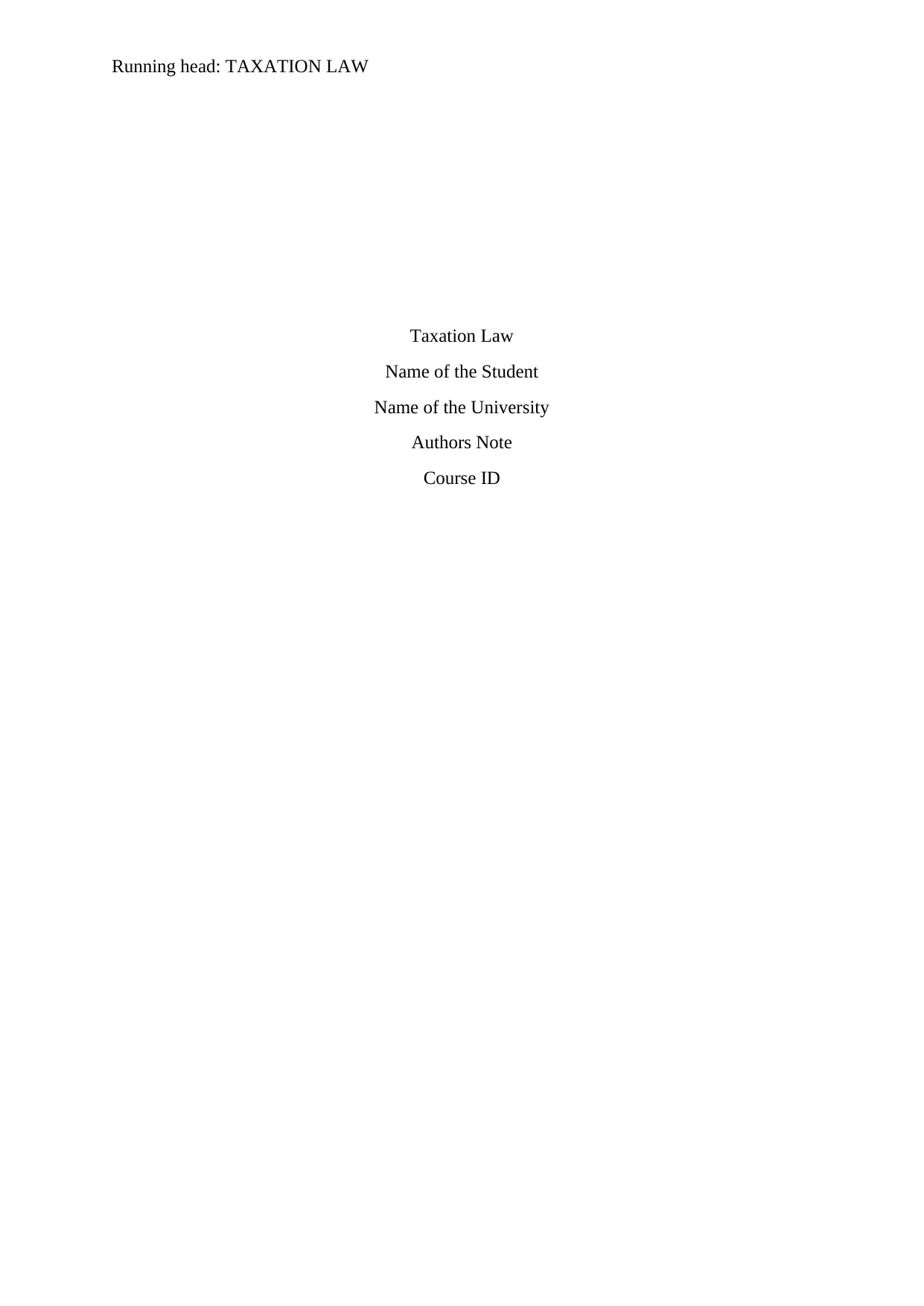
Running head: TAXATION LAW
Taxation Law
Name of the Student
Name of the University
Authors Note
Course ID
Taxation Law
Name of the Student
Name of the University
Authors Note
Course ID
Paraphrase This Document
Need a fresh take? Get an instant paraphrase of this document with our AI Paraphraser
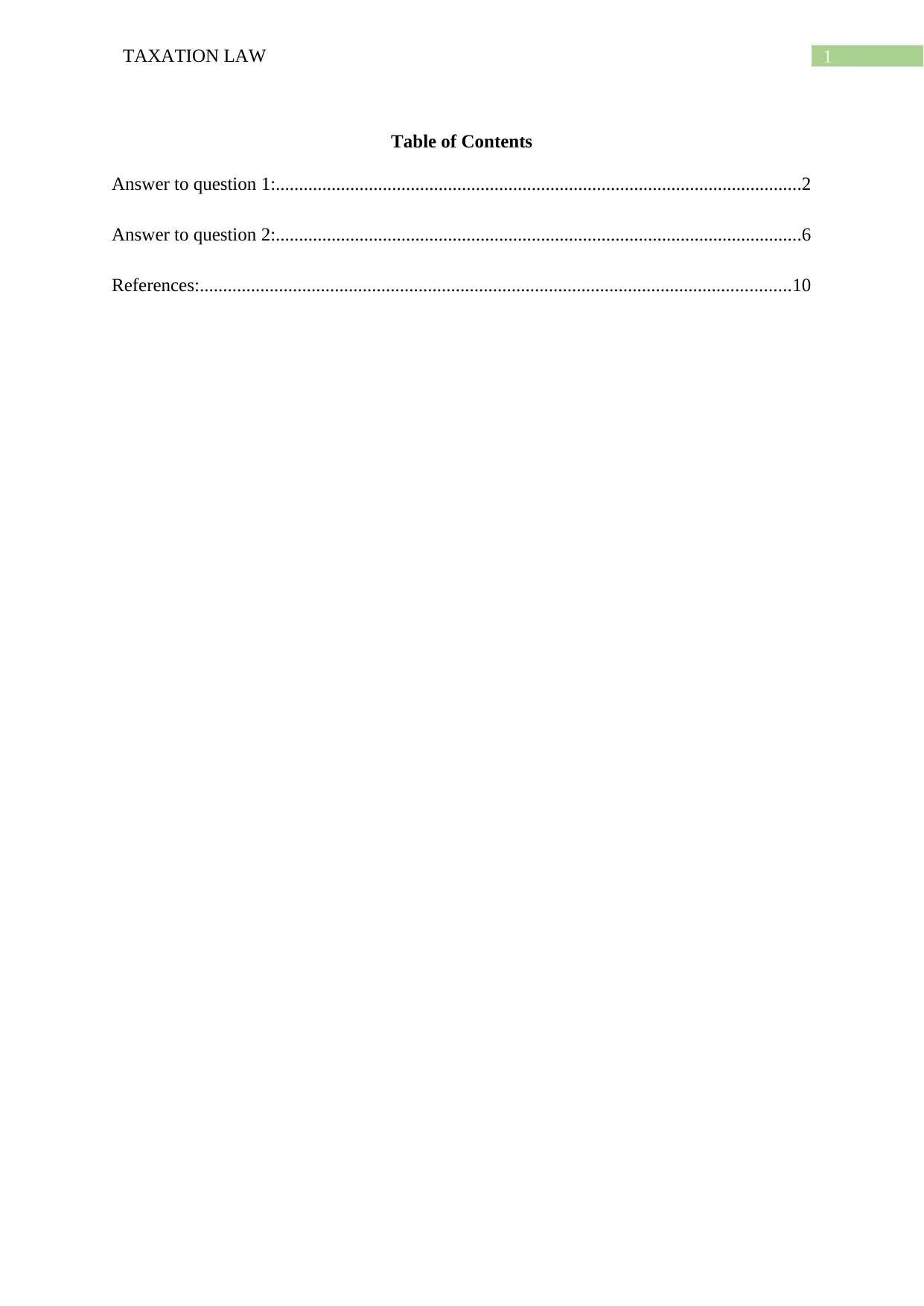
1TAXATION LAW
Table of Contents
Answer to question 1:.................................................................................................................2
Answer to question 2:.................................................................................................................6
References:...............................................................................................................................10
Table of Contents
Answer to question 1:.................................................................................................................2
Answer to question 2:.................................................................................................................6
References:...............................................................................................................................10
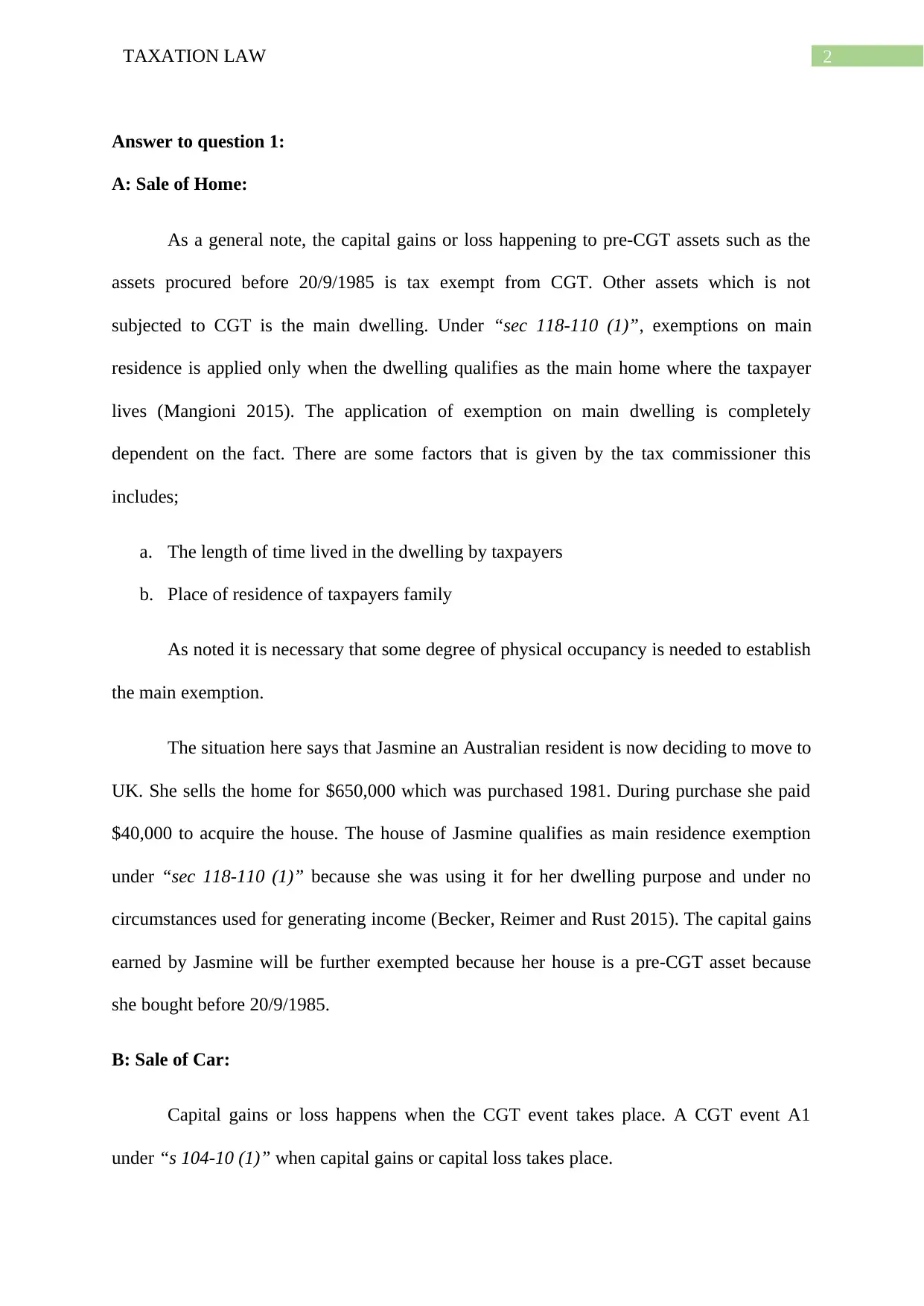
2TAXATION LAW
Answer to question 1:
A: Sale of Home:
As a general note, the capital gains or loss happening to pre-CGT assets such as the
assets procured before 20/9/1985 is tax exempt from CGT. Other assets which is not
subjected to CGT is the main dwelling. Under “sec 118-110 (1)”, exemptions on main
residence is applied only when the dwelling qualifies as the main home where the taxpayer
lives (Mangioni 2015). The application of exemption on main dwelling is completely
dependent on the fact. There are some factors that is given by the tax commissioner this
includes;
a. The length of time lived in the dwelling by taxpayers
b. Place of residence of taxpayers family
As noted it is necessary that some degree of physical occupancy is needed to establish
the main exemption.
The situation here says that Jasmine an Australian resident is now deciding to move to
UK. She sells the home for $650,000 which was purchased 1981. During purchase she paid
$40,000 to acquire the house. The house of Jasmine qualifies as main residence exemption
under “sec 118-110 (1)” because she was using it for her dwelling purpose and under no
circumstances used for generating income (Becker, Reimer and Rust 2015). The capital gains
earned by Jasmine will be further exempted because her house is a pre-CGT asset because
she bought before 20/9/1985.
B: Sale of Car:
Capital gains or loss happens when the CGT event takes place. A CGT event A1
under “s 104-10 (1)” when capital gains or capital loss takes place.
Answer to question 1:
A: Sale of Home:
As a general note, the capital gains or loss happening to pre-CGT assets such as the
assets procured before 20/9/1985 is tax exempt from CGT. Other assets which is not
subjected to CGT is the main dwelling. Under “sec 118-110 (1)”, exemptions on main
residence is applied only when the dwelling qualifies as the main home where the taxpayer
lives (Mangioni 2015). The application of exemption on main dwelling is completely
dependent on the fact. There are some factors that is given by the tax commissioner this
includes;
a. The length of time lived in the dwelling by taxpayers
b. Place of residence of taxpayers family
As noted it is necessary that some degree of physical occupancy is needed to establish
the main exemption.
The situation here says that Jasmine an Australian resident is now deciding to move to
UK. She sells the home for $650,000 which was purchased 1981. During purchase she paid
$40,000 to acquire the house. The house of Jasmine qualifies as main residence exemption
under “sec 118-110 (1)” because she was using it for her dwelling purpose and under no
circumstances used for generating income (Becker, Reimer and Rust 2015). The capital gains
earned by Jasmine will be further exempted because her house is a pre-CGT asset because
she bought before 20/9/1985.
B: Sale of Car:
Capital gains or loss happens when the CGT event takes place. A CGT event A1
under “s 104-10 (1)” when capital gains or capital loss takes place.
⊘ This is a preview!⊘
Do you want full access?
Subscribe today to unlock all pages.

Trusted by 1+ million students worldwide
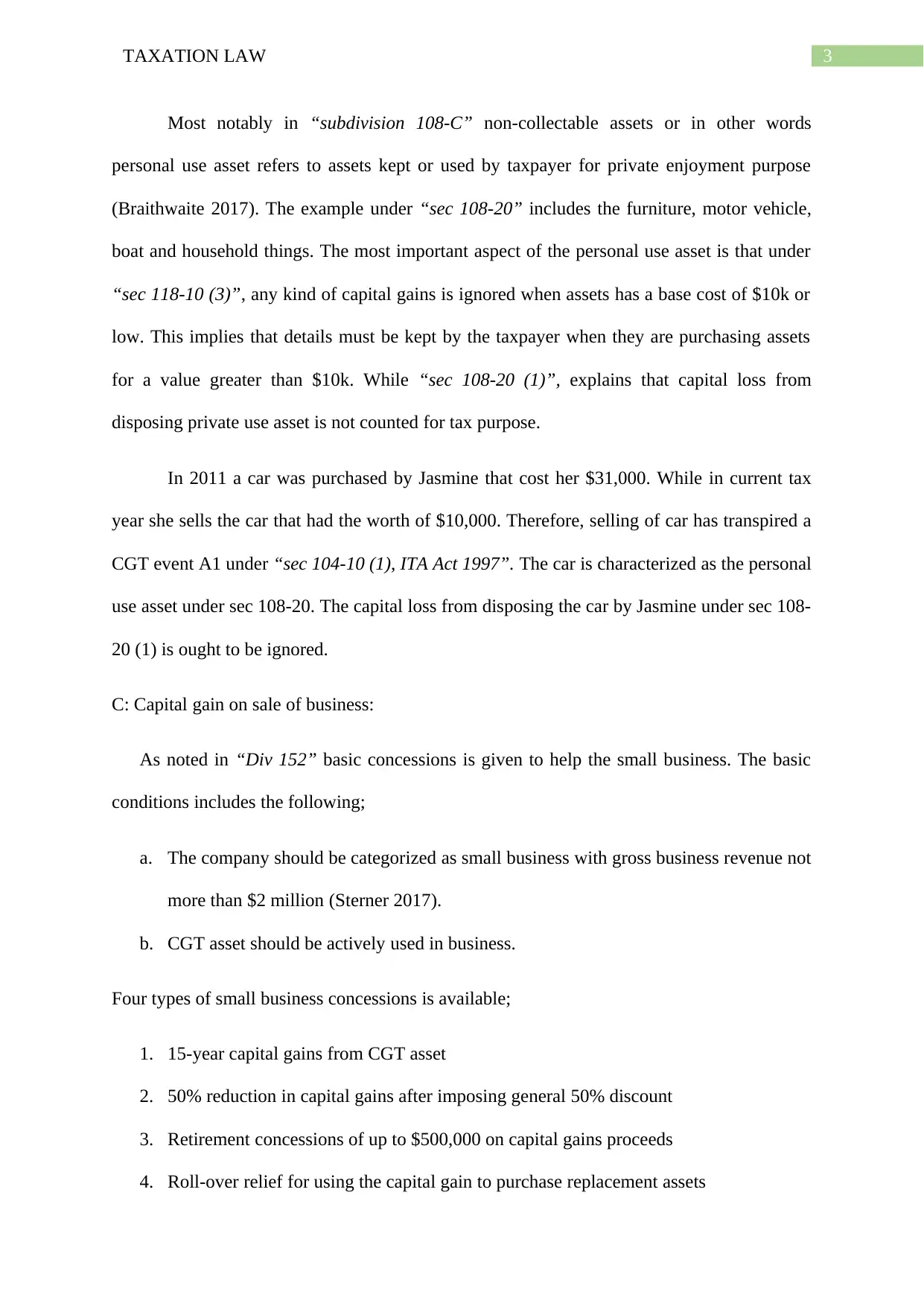
3TAXATION LAW
Most notably in “subdivision 108-C” non-collectable assets or in other words
personal use asset refers to assets kept or used by taxpayer for private enjoyment purpose
(Braithwaite 2017). The example under “sec 108-20” includes the furniture, motor vehicle,
boat and household things. The most important aspect of the personal use asset is that under
“sec 118-10 (3)”, any kind of capital gains is ignored when assets has a base cost of $10k or
low. This implies that details must be kept by the taxpayer when they are purchasing assets
for a value greater than $10k. While “sec 108-20 (1)”, explains that capital loss from
disposing private use asset is not counted for tax purpose.
In 2011 a car was purchased by Jasmine that cost her $31,000. While in current tax
year she sells the car that had the worth of $10,000. Therefore, selling of car has transpired a
CGT event A1 under “sec 104-10 (1), ITA Act 1997”. The car is characterized as the personal
use asset under sec 108-20. The capital loss from disposing the car by Jasmine under sec 108-
20 (1) is ought to be ignored.
C: Capital gain on sale of business:
As noted in “Div 152” basic concessions is given to help the small business. The basic
conditions includes the following;
a. The company should be categorized as small business with gross business revenue not
more than $2 million (Sterner 2017).
b. CGT asset should be actively used in business.
Four types of small business concessions is available;
1. 15-year capital gains from CGT asset
2. 50% reduction in capital gains after imposing general 50% discount
3. Retirement concessions of up to $500,000 on capital gains proceeds
4. Roll-over relief for using the capital gain to purchase replacement assets
Most notably in “subdivision 108-C” non-collectable assets or in other words
personal use asset refers to assets kept or used by taxpayer for private enjoyment purpose
(Braithwaite 2017). The example under “sec 108-20” includes the furniture, motor vehicle,
boat and household things. The most important aspect of the personal use asset is that under
“sec 118-10 (3)”, any kind of capital gains is ignored when assets has a base cost of $10k or
low. This implies that details must be kept by the taxpayer when they are purchasing assets
for a value greater than $10k. While “sec 108-20 (1)”, explains that capital loss from
disposing private use asset is not counted for tax purpose.
In 2011 a car was purchased by Jasmine that cost her $31,000. While in current tax
year she sells the car that had the worth of $10,000. Therefore, selling of car has transpired a
CGT event A1 under “sec 104-10 (1), ITA Act 1997”. The car is characterized as the personal
use asset under sec 108-20. The capital loss from disposing the car by Jasmine under sec 108-
20 (1) is ought to be ignored.
C: Capital gain on sale of business:
As noted in “Div 152” basic concessions is given to help the small business. The basic
conditions includes the following;
a. The company should be categorized as small business with gross business revenue not
more than $2 million (Sterner 2017).
b. CGT asset should be actively used in business.
Four types of small business concessions is available;
1. 15-year capital gains from CGT asset
2. 50% reduction in capital gains after imposing general 50% discount
3. Retirement concessions of up to $500,000 on capital gains proceeds
4. Roll-over relief for using the capital gain to purchase replacement assets
Paraphrase This Document
Need a fresh take? Get an instant paraphrase of this document with our AI Paraphraser
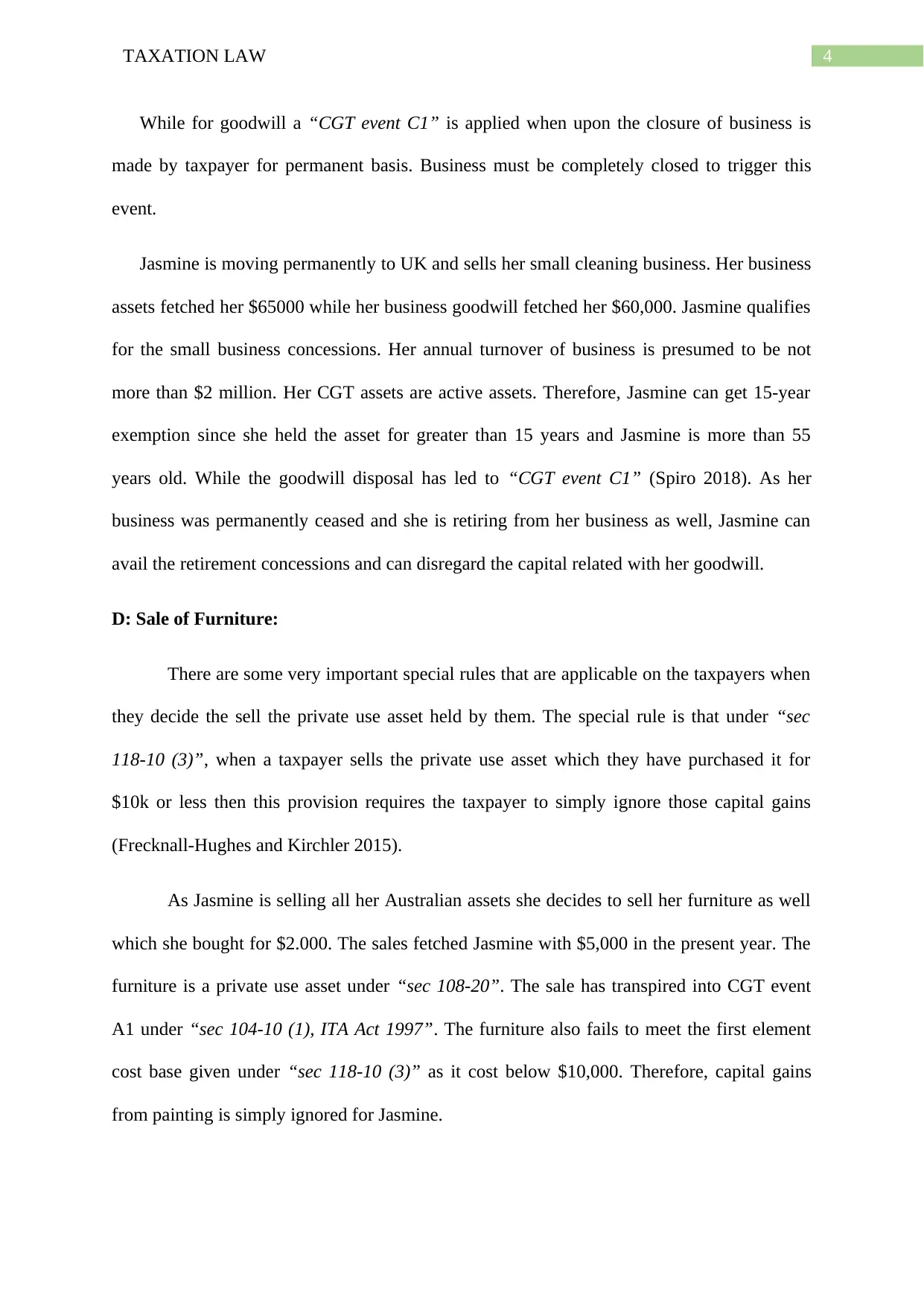
4TAXATION LAW
While for goodwill a “CGT event C1” is applied when upon the closure of business is
made by taxpayer for permanent basis. Business must be completely closed to trigger this
event.
Jasmine is moving permanently to UK and sells her small cleaning business. Her business
assets fetched her $65000 while her business goodwill fetched her $60,000. Jasmine qualifies
for the small business concessions. Her annual turnover of business is presumed to be not
more than $2 million. Her CGT assets are active assets. Therefore, Jasmine can get 15-year
exemption since she held the asset for greater than 15 years and Jasmine is more than 55
years old. While the goodwill disposal has led to “CGT event C1” (Spiro 2018). As her
business was permanently ceased and she is retiring from her business as well, Jasmine can
avail the retirement concessions and can disregard the capital related with her goodwill.
D: Sale of Furniture:
There are some very important special rules that are applicable on the taxpayers when
they decide the sell the private use asset held by them. The special rule is that under “sec
118-10 (3)”, when a taxpayer sells the private use asset which they have purchased it for
$10k or less then this provision requires the taxpayer to simply ignore those capital gains
(Frecknall-Hughes and Kirchler 2015).
As Jasmine is selling all her Australian assets she decides to sell her furniture as well
which she bought for $2.000. The sales fetched Jasmine with $5,000 in the present year. The
furniture is a private use asset under “sec 108-20”. The sale has transpired into CGT event
A1 under “sec 104-10 (1), ITA Act 1997”. The furniture also fails to meet the first element
cost base given under “sec 118-10 (3)” as it cost below $10,000. Therefore, capital gains
from painting is simply ignored for Jasmine.
While for goodwill a “CGT event C1” is applied when upon the closure of business is
made by taxpayer for permanent basis. Business must be completely closed to trigger this
event.
Jasmine is moving permanently to UK and sells her small cleaning business. Her business
assets fetched her $65000 while her business goodwill fetched her $60,000. Jasmine qualifies
for the small business concessions. Her annual turnover of business is presumed to be not
more than $2 million. Her CGT assets are active assets. Therefore, Jasmine can get 15-year
exemption since she held the asset for greater than 15 years and Jasmine is more than 55
years old. While the goodwill disposal has led to “CGT event C1” (Spiro 2018). As her
business was permanently ceased and she is retiring from her business as well, Jasmine can
avail the retirement concessions and can disregard the capital related with her goodwill.
D: Sale of Furniture:
There are some very important special rules that are applicable on the taxpayers when
they decide the sell the private use asset held by them. The special rule is that under “sec
118-10 (3)”, when a taxpayer sells the private use asset which they have purchased it for
$10k or less then this provision requires the taxpayer to simply ignore those capital gains
(Frecknall-Hughes and Kirchler 2015).
As Jasmine is selling all her Australian assets she decides to sell her furniture as well
which she bought for $2.000. The sales fetched Jasmine with $5,000 in the present year. The
furniture is a private use asset under “sec 108-20”. The sale has transpired into CGT event
A1 under “sec 104-10 (1), ITA Act 1997”. The furniture also fails to meet the first element
cost base given under “sec 118-10 (3)” as it cost below $10,000. Therefore, capital gains
from painting is simply ignored for Jasmine.
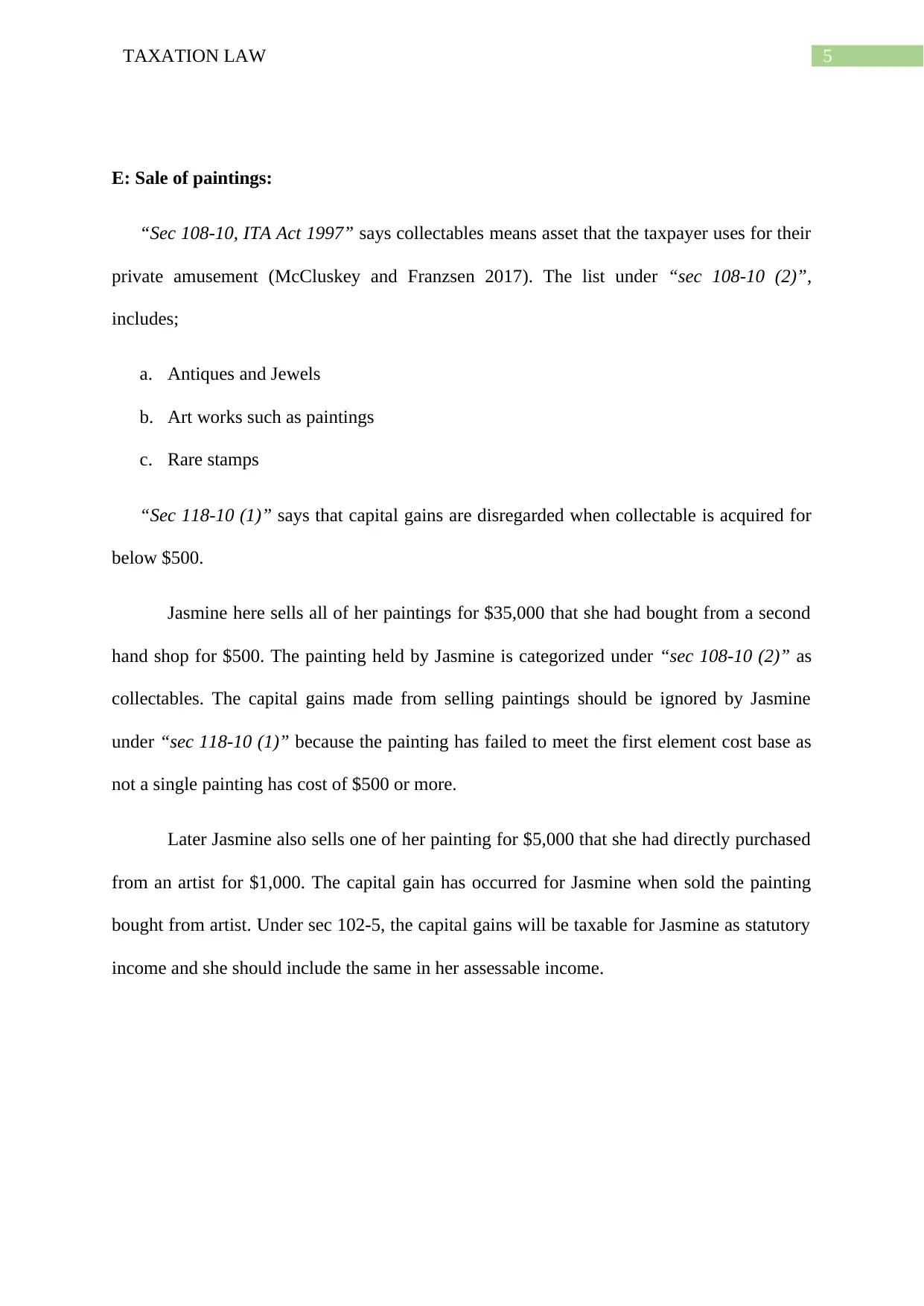
5TAXATION LAW
E: Sale of paintings:
“Sec 108-10, ITA Act 1997” says collectables means asset that the taxpayer uses for their
private amusement (McCluskey and Franzsen 2017). The list under “sec 108-10 (2)”,
includes;
a. Antiques and Jewels
b. Art works such as paintings
c. Rare stamps
“Sec 118-10 (1)” says that capital gains are disregarded when collectable is acquired for
below $500.
Jasmine here sells all of her paintings for $35,000 that she had bought from a second
hand shop for $500. The painting held by Jasmine is categorized under “sec 108-10 (2)” as
collectables. The capital gains made from selling paintings should be ignored by Jasmine
under “sec 118-10 (1)” because the painting has failed to meet the first element cost base as
not a single painting has cost of $500 or more.
Later Jasmine also sells one of her painting for $5,000 that she had directly purchased
from an artist for $1,000. The capital gain has occurred for Jasmine when sold the painting
bought from artist. Under sec 102-5, the capital gains will be taxable for Jasmine as statutory
income and she should include the same in her assessable income.
E: Sale of paintings:
“Sec 108-10, ITA Act 1997” says collectables means asset that the taxpayer uses for their
private amusement (McCluskey and Franzsen 2017). The list under “sec 108-10 (2)”,
includes;
a. Antiques and Jewels
b. Art works such as paintings
c. Rare stamps
“Sec 118-10 (1)” says that capital gains are disregarded when collectable is acquired for
below $500.
Jasmine here sells all of her paintings for $35,000 that she had bought from a second
hand shop for $500. The painting held by Jasmine is categorized under “sec 108-10 (2)” as
collectables. The capital gains made from selling paintings should be ignored by Jasmine
under “sec 118-10 (1)” because the painting has failed to meet the first element cost base as
not a single painting has cost of $500 or more.
Later Jasmine also sells one of her painting for $5,000 that she had directly purchased
from an artist for $1,000. The capital gain has occurred for Jasmine when sold the painting
bought from artist. Under sec 102-5, the capital gains will be taxable for Jasmine as statutory
income and she should include the same in her assessable income.
⊘ This is a preview!⊘
Do you want full access?
Subscribe today to unlock all pages.

Trusted by 1+ million students worldwide
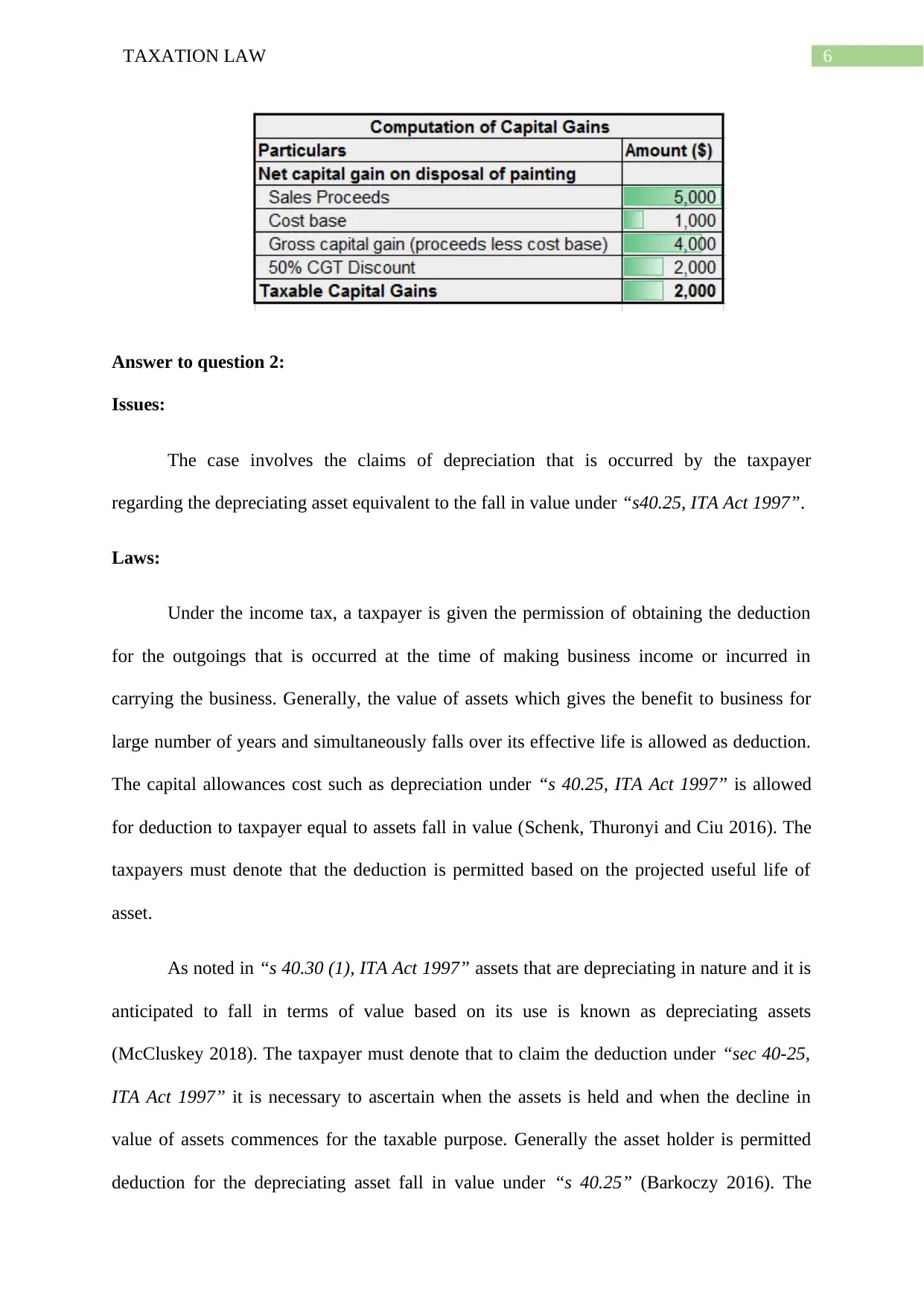
6TAXATION LAW
Answer to question 2:
Issues:
The case involves the claims of depreciation that is occurred by the taxpayer
regarding the depreciating asset equivalent to the fall in value under “s40.25, ITA Act 1997”.
Laws:
Under the income tax, a taxpayer is given the permission of obtaining the deduction
for the outgoings that is occurred at the time of making business income or incurred in
carrying the business. Generally, the value of assets which gives the benefit to business for
large number of years and simultaneously falls over its effective life is allowed as deduction.
The capital allowances cost such as depreciation under “s 40.25, ITA Act 1997” is allowed
for deduction to taxpayer equal to assets fall in value (Schenk, Thuronyi and Ciu 2016). The
taxpayers must denote that the deduction is permitted based on the projected useful life of
asset.
As noted in “s 40.30 (1), ITA Act 1997” assets that are depreciating in nature and it is
anticipated to fall in terms of value based on its use is known as depreciating assets
(McCluskey 2018). The taxpayer must denote that to claim the deduction under “sec 40-25,
ITA Act 1997” it is necessary to ascertain when the assets is held and when the decline in
value of assets commences for the taxable purpose. Generally the asset holder is permitted
deduction for the depreciating asset fall in value under “s 40.25” (Barkoczy 2016). The
Answer to question 2:
Issues:
The case involves the claims of depreciation that is occurred by the taxpayer
regarding the depreciating asset equivalent to the fall in value under “s40.25, ITA Act 1997”.
Laws:
Under the income tax, a taxpayer is given the permission of obtaining the deduction
for the outgoings that is occurred at the time of making business income or incurred in
carrying the business. Generally, the value of assets which gives the benefit to business for
large number of years and simultaneously falls over its effective life is allowed as deduction.
The capital allowances cost such as depreciation under “s 40.25, ITA Act 1997” is allowed
for deduction to taxpayer equal to assets fall in value (Schenk, Thuronyi and Ciu 2016). The
taxpayers must denote that the deduction is permitted based on the projected useful life of
asset.
As noted in “s 40.30 (1), ITA Act 1997” assets that are depreciating in nature and it is
anticipated to fall in terms of value based on its use is known as depreciating assets
(McCluskey 2018). The taxpayer must denote that to claim the deduction under “sec 40-25,
ITA Act 1997” it is necessary to ascertain when the assets is held and when the decline in
value of assets commences for the taxable purpose. Generally the asset holder is permitted
deduction for the depreciating asset fall in value under “s 40.25” (Barkoczy 2016). The
Paraphrase This Document
Need a fresh take? Get an instant paraphrase of this document with our AI Paraphraser
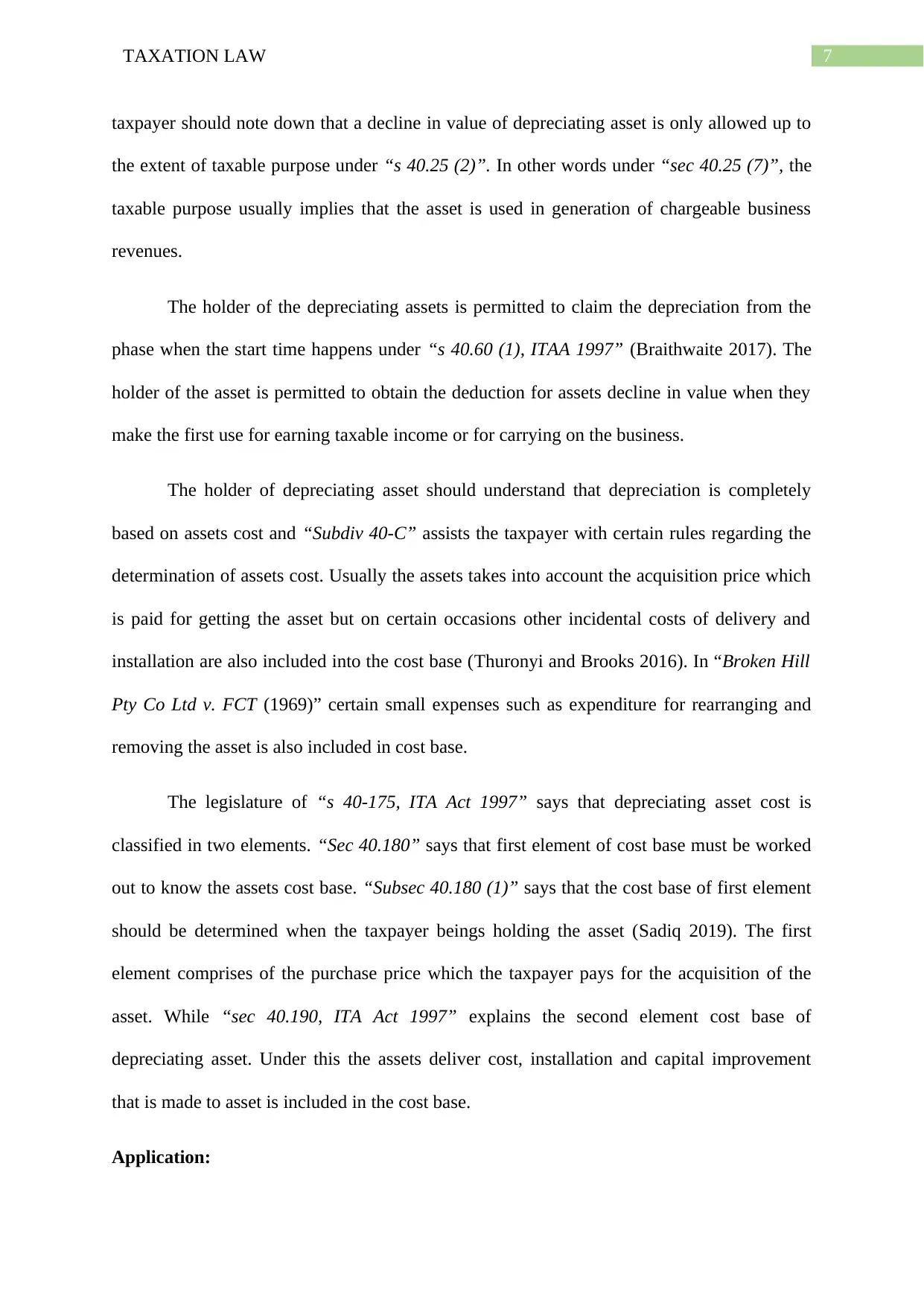
7TAXATION LAW
taxpayer should note down that a decline in value of depreciating asset is only allowed up to
the extent of taxable purpose under “s 40.25 (2)”. In other words under “sec 40.25 (7)”, the
taxable purpose usually implies that the asset is used in generation of chargeable business
revenues.
The holder of the depreciating assets is permitted to claim the depreciation from the
phase when the start time happens under “s 40.60 (1), ITAA 1997” (Braithwaite 2017). The
holder of the asset is permitted to obtain the deduction for assets decline in value when they
make the first use for earning taxable income or for carrying on the business.
The holder of depreciating asset should understand that depreciation is completely
based on assets cost and “Subdiv 40-C” assists the taxpayer with certain rules regarding the
determination of assets cost. Usually the assets takes into account the acquisition price which
is paid for getting the asset but on certain occasions other incidental costs of delivery and
installation are also included into the cost base (Thuronyi and Brooks 2016). In “Broken Hill
Pty Co Ltd v. FCT (1969)” certain small expenses such as expenditure for rearranging and
removing the asset is also included in cost base.
The legislature of “s 40-175, ITA Act 1997” says that depreciating asset cost is
classified in two elements. “Sec 40.180” says that first element of cost base must be worked
out to know the assets cost base. “Subsec 40.180 (1)” says that the cost base of first element
should be determined when the taxpayer beings holding the asset (Sadiq 2019). The first
element comprises of the purchase price which the taxpayer pays for the acquisition of the
asset. While “sec 40.190, ITA Act 1997” explains the second element cost base of
depreciating asset. Under this the assets deliver cost, installation and capital improvement
that is made to asset is included in the cost base.
Application:
taxpayer should note down that a decline in value of depreciating asset is only allowed up to
the extent of taxable purpose under “s 40.25 (2)”. In other words under “sec 40.25 (7)”, the
taxable purpose usually implies that the asset is used in generation of chargeable business
revenues.
The holder of the depreciating assets is permitted to claim the depreciation from the
phase when the start time happens under “s 40.60 (1), ITAA 1997” (Braithwaite 2017). The
holder of the asset is permitted to obtain the deduction for assets decline in value when they
make the first use for earning taxable income or for carrying on the business.
The holder of depreciating asset should understand that depreciation is completely
based on assets cost and “Subdiv 40-C” assists the taxpayer with certain rules regarding the
determination of assets cost. Usually the assets takes into account the acquisition price which
is paid for getting the asset but on certain occasions other incidental costs of delivery and
installation are also included into the cost base (Thuronyi and Brooks 2016). In “Broken Hill
Pty Co Ltd v. FCT (1969)” certain small expenses such as expenditure for rearranging and
removing the asset is also included in cost base.
The legislature of “s 40-175, ITA Act 1997” says that depreciating asset cost is
classified in two elements. “Sec 40.180” says that first element of cost base must be worked
out to know the assets cost base. “Subsec 40.180 (1)” says that the cost base of first element
should be determined when the taxpayer beings holding the asset (Sadiq 2019). The first
element comprises of the purchase price which the taxpayer pays for the acquisition of the
asset. While “sec 40.190, ITA Act 1997” explains the second element cost base of
depreciating asset. Under this the assets deliver cost, installation and capital improvement
that is made to asset is included in the cost base.
Application:
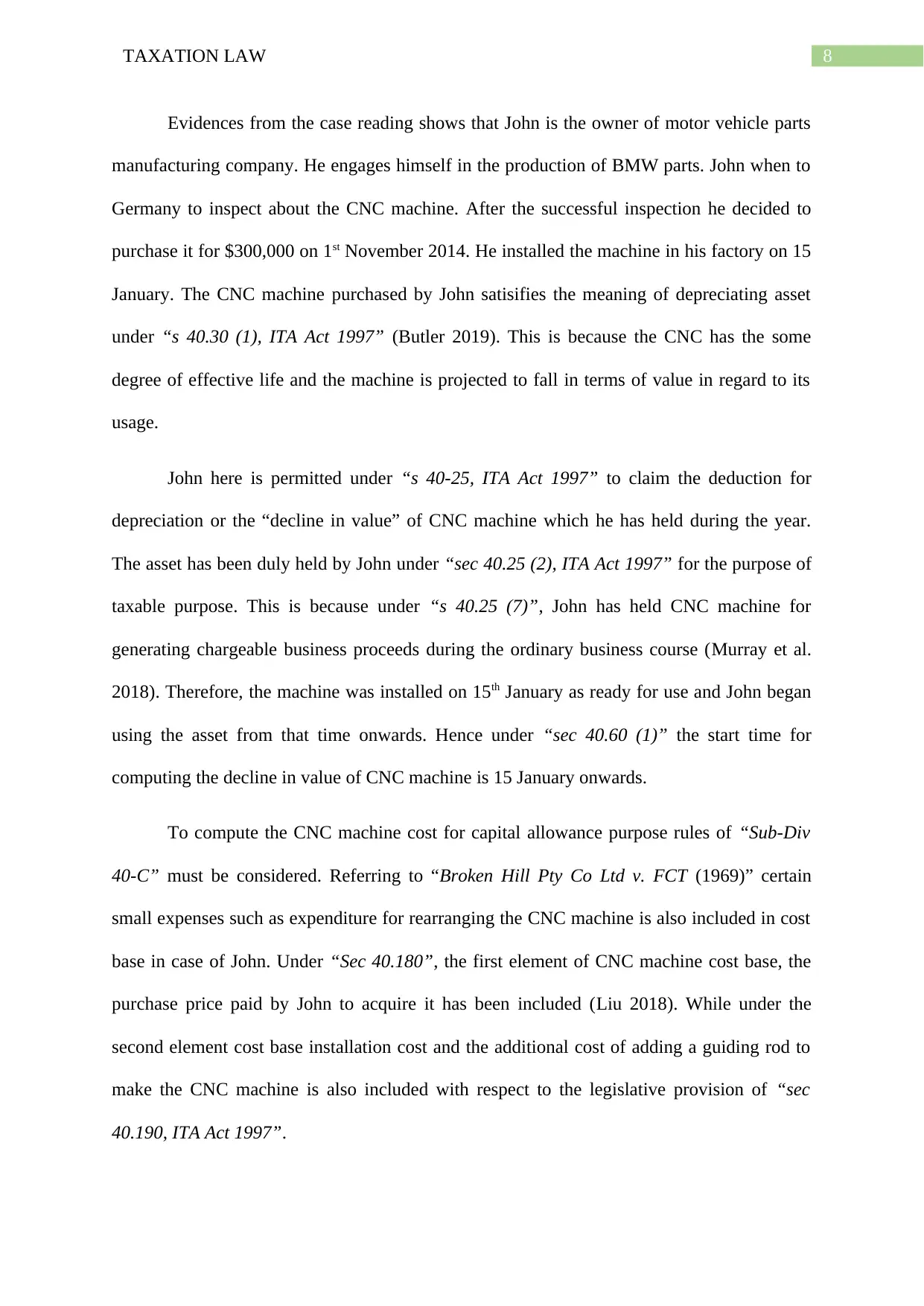
8TAXATION LAW
Evidences from the case reading shows that John is the owner of motor vehicle parts
manufacturing company. He engages himself in the production of BMW parts. John when to
Germany to inspect about the CNC machine. After the successful inspection he decided to
purchase it for $300,000 on 1st November 2014. He installed the machine in his factory on 15
January. The CNC machine purchased by John satisifies the meaning of depreciating asset
under “s 40.30 (1), ITA Act 1997” (Butler 2019). This is because the CNC has the some
degree of effective life and the machine is projected to fall in terms of value in regard to its
usage.
John here is permitted under “s 40-25, ITA Act 1997” to claim the deduction for
depreciation or the “decline in value” of CNC machine which he has held during the year.
The asset has been duly held by John under “sec 40.25 (2), ITA Act 1997” for the purpose of
taxable purpose. This is because under “s 40.25 (7)”, John has held CNC machine for
generating chargeable business proceeds during the ordinary business course (Murray et al.
2018). Therefore, the machine was installed on 15th January as ready for use and John began
using the asset from that time onwards. Hence under “sec 40.60 (1)” the start time for
computing the decline in value of CNC machine is 15 January onwards.
To compute the CNC machine cost for capital allowance purpose rules of “Sub-Div
40-C” must be considered. Referring to “Broken Hill Pty Co Ltd v. FCT (1969)” certain
small expenses such as expenditure for rearranging the CNC machine is also included in cost
base in case of John. Under “Sec 40.180”, the first element of CNC machine cost base, the
purchase price paid by John to acquire it has been included (Liu 2018). While under the
second element cost base installation cost and the additional cost of adding a guiding rod to
make the CNC machine is also included with respect to the legislative provision of “sec
40.190, ITA Act 1997”.
Evidences from the case reading shows that John is the owner of motor vehicle parts
manufacturing company. He engages himself in the production of BMW parts. John when to
Germany to inspect about the CNC machine. After the successful inspection he decided to
purchase it for $300,000 on 1st November 2014. He installed the machine in his factory on 15
January. The CNC machine purchased by John satisifies the meaning of depreciating asset
under “s 40.30 (1), ITA Act 1997” (Butler 2019). This is because the CNC has the some
degree of effective life and the machine is projected to fall in terms of value in regard to its
usage.
John here is permitted under “s 40-25, ITA Act 1997” to claim the deduction for
depreciation or the “decline in value” of CNC machine which he has held during the year.
The asset has been duly held by John under “sec 40.25 (2), ITA Act 1997” for the purpose of
taxable purpose. This is because under “s 40.25 (7)”, John has held CNC machine for
generating chargeable business proceeds during the ordinary business course (Murray et al.
2018). Therefore, the machine was installed on 15th January as ready for use and John began
using the asset from that time onwards. Hence under “sec 40.60 (1)” the start time for
computing the decline in value of CNC machine is 15 January onwards.
To compute the CNC machine cost for capital allowance purpose rules of “Sub-Div
40-C” must be considered. Referring to “Broken Hill Pty Co Ltd v. FCT (1969)” certain
small expenses such as expenditure for rearranging the CNC machine is also included in cost
base in case of John. Under “Sec 40.180”, the first element of CNC machine cost base, the
purchase price paid by John to acquire it has been included (Liu 2018). While under the
second element cost base installation cost and the additional cost of adding a guiding rod to
make the CNC machine is also included with respect to the legislative provision of “sec
40.190, ITA Act 1997”.
⊘ This is a preview!⊘
Do you want full access?
Subscribe today to unlock all pages.

Trusted by 1+ million students worldwide
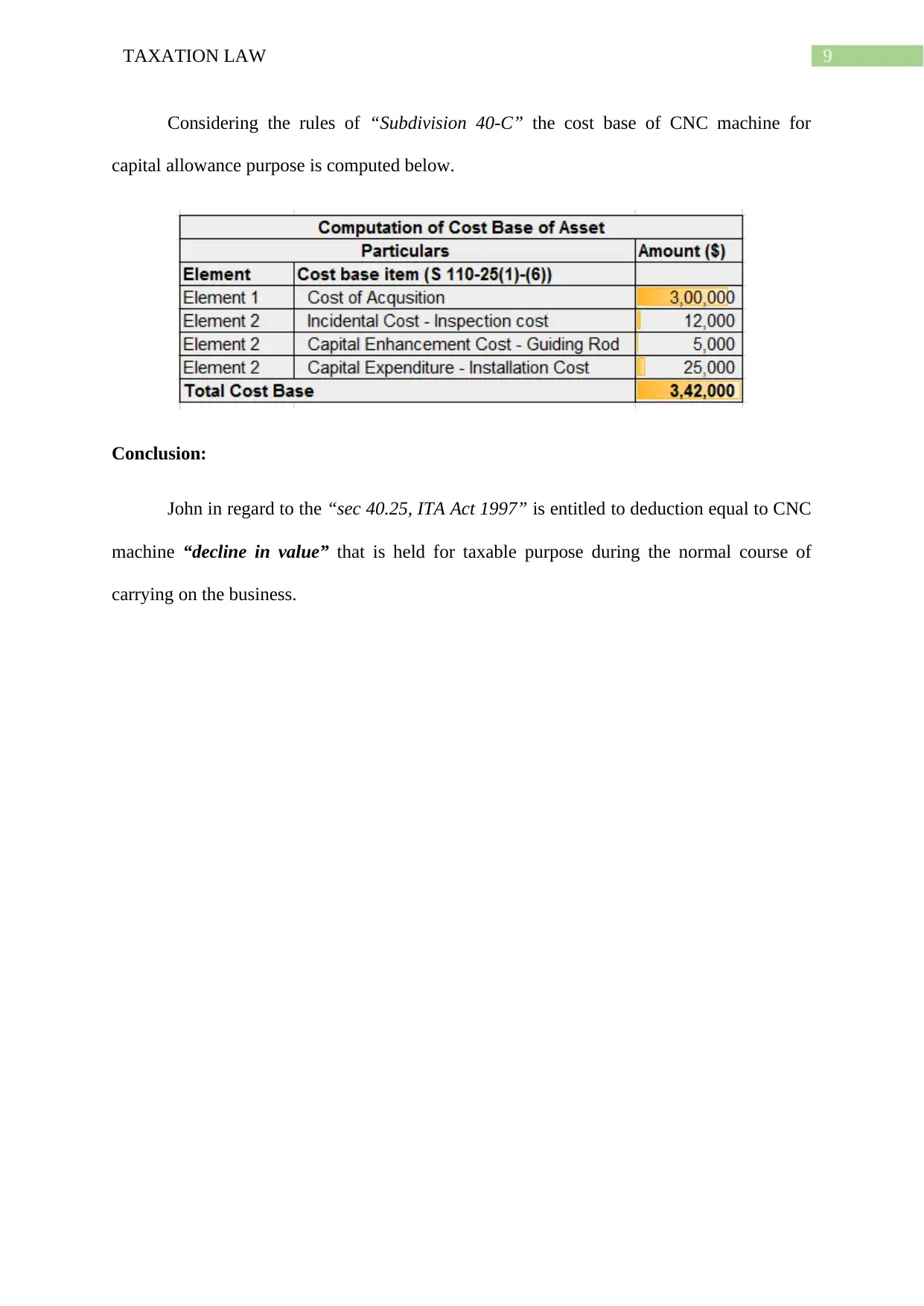
9TAXATION LAW
Considering the rules of “Subdivision 40-C” the cost base of CNC machine for
capital allowance purpose is computed below.
Conclusion:
John in regard to the “sec 40.25, ITA Act 1997” is entitled to deduction equal to CNC
machine “decline in value” that is held for taxable purpose during the normal course of
carrying on the business.
Considering the rules of “Subdivision 40-C” the cost base of CNC machine for
capital allowance purpose is computed below.
Conclusion:
John in regard to the “sec 40.25, ITA Act 1997” is entitled to deduction equal to CNC
machine “decline in value” that is held for taxable purpose during the normal course of
carrying on the business.
Paraphrase This Document
Need a fresh take? Get an instant paraphrase of this document with our AI Paraphraser
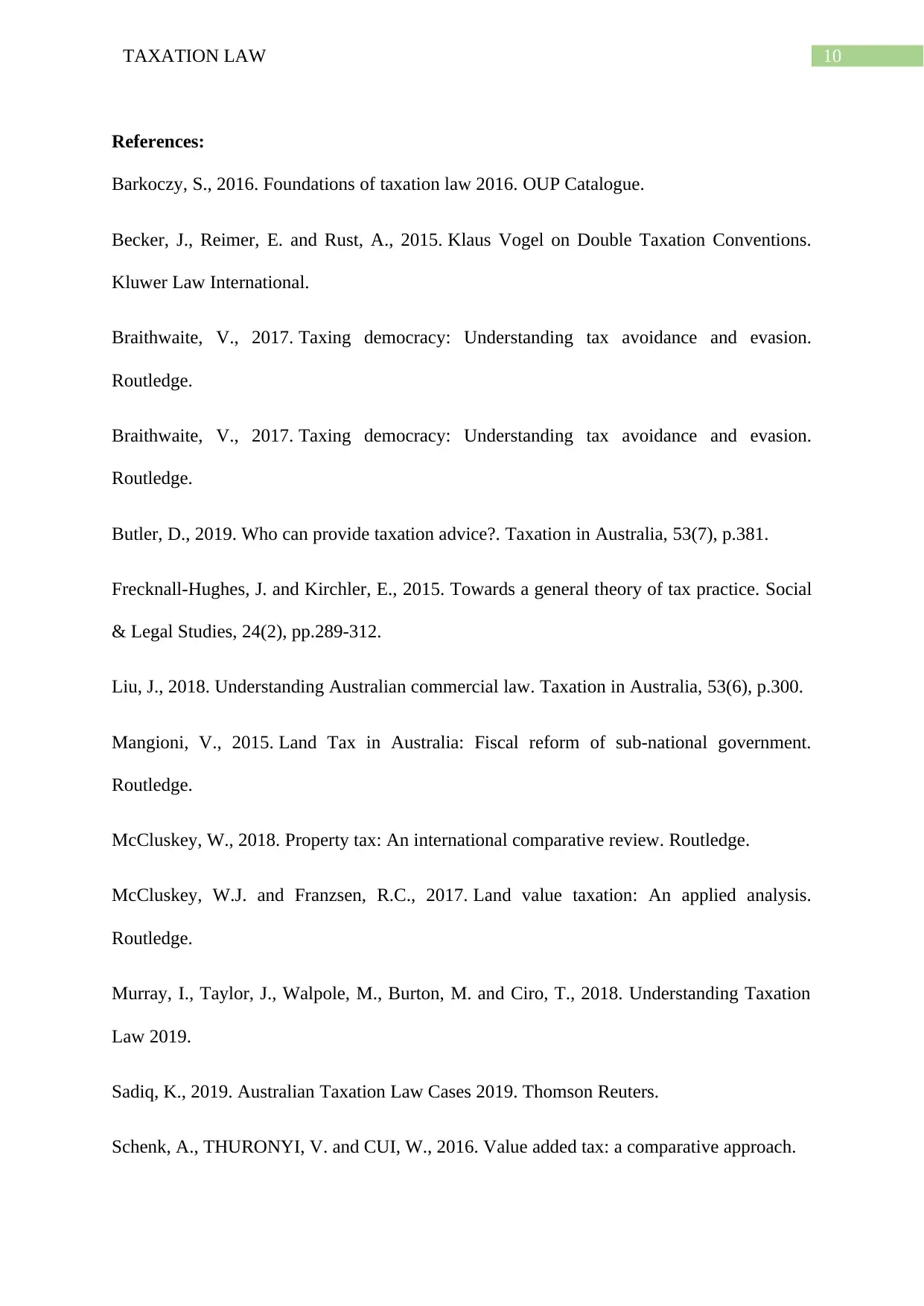
10TAXATION LAW
References:
Barkoczy, S., 2016. Foundations of taxation law 2016. OUP Catalogue.
Becker, J., Reimer, E. and Rust, A., 2015. Klaus Vogel on Double Taxation Conventions.
Kluwer Law International.
Braithwaite, V., 2017. Taxing democracy: Understanding tax avoidance and evasion.
Routledge.
Braithwaite, V., 2017. Taxing democracy: Understanding tax avoidance and evasion.
Routledge.
Butler, D., 2019. Who can provide taxation advice?. Taxation in Australia, 53(7), p.381.
Frecknall-Hughes, J. and Kirchler, E., 2015. Towards a general theory of tax practice. Social
& Legal Studies, 24(2), pp.289-312.
Liu, J., 2018. Understanding Australian commercial law. Taxation in Australia, 53(6), p.300.
Mangioni, V., 2015. Land Tax in Australia: Fiscal reform of sub-national government.
Routledge.
McCluskey, W., 2018. Property tax: An international comparative review. Routledge.
McCluskey, W.J. and Franzsen, R.C., 2017. Land value taxation: An applied analysis.
Routledge.
Murray, I., Taylor, J., Walpole, M., Burton, M. and Ciro, T., 2018. Understanding Taxation
Law 2019.
Sadiq, K., 2019. Australian Taxation Law Cases 2019. Thomson Reuters.
Schenk, A., THURONYI, V. and CUI, W., 2016. Value added tax: a comparative approach.
References:
Barkoczy, S., 2016. Foundations of taxation law 2016. OUP Catalogue.
Becker, J., Reimer, E. and Rust, A., 2015. Klaus Vogel on Double Taxation Conventions.
Kluwer Law International.
Braithwaite, V., 2017. Taxing democracy: Understanding tax avoidance and evasion.
Routledge.
Braithwaite, V., 2017. Taxing democracy: Understanding tax avoidance and evasion.
Routledge.
Butler, D., 2019. Who can provide taxation advice?. Taxation in Australia, 53(7), p.381.
Frecknall-Hughes, J. and Kirchler, E., 2015. Towards a general theory of tax practice. Social
& Legal Studies, 24(2), pp.289-312.
Liu, J., 2018. Understanding Australian commercial law. Taxation in Australia, 53(6), p.300.
Mangioni, V., 2015. Land Tax in Australia: Fiscal reform of sub-national government.
Routledge.
McCluskey, W., 2018. Property tax: An international comparative review. Routledge.
McCluskey, W.J. and Franzsen, R.C., 2017. Land value taxation: An applied analysis.
Routledge.
Murray, I., Taylor, J., Walpole, M., Burton, M. and Ciro, T., 2018. Understanding Taxation
Law 2019.
Sadiq, K., 2019. Australian Taxation Law Cases 2019. Thomson Reuters.
Schenk, A., THURONYI, V. and CUI, W., 2016. Value added tax: a comparative approach.
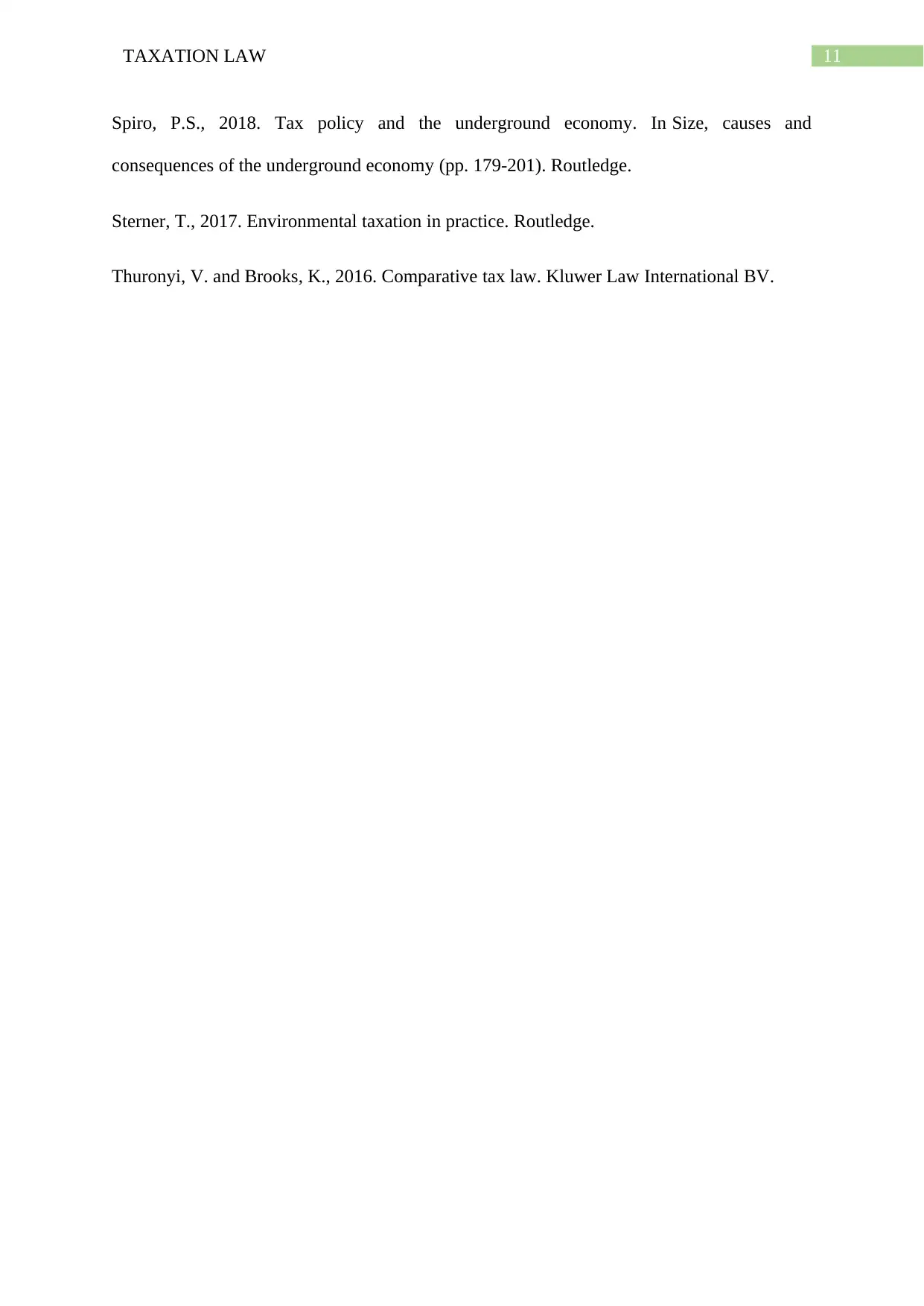
11TAXATION LAW
Spiro, P.S., 2018. Tax policy and the underground economy. In Size, causes and
consequences of the underground economy (pp. 179-201). Routledge.
Sterner, T., 2017. Environmental taxation in practice. Routledge.
Thuronyi, V. and Brooks, K., 2016. Comparative tax law. Kluwer Law International BV.
Spiro, P.S., 2018. Tax policy and the underground economy. In Size, causes and
consequences of the underground economy (pp. 179-201). Routledge.
Sterner, T., 2017. Environmental taxation in practice. Routledge.
Thuronyi, V. and Brooks, K., 2016. Comparative tax law. Kluwer Law International BV.
⊘ This is a preview!⊘
Do you want full access?
Subscribe today to unlock all pages.

Trusted by 1+ million students worldwide
1 out of 12
Related Documents
Your All-in-One AI-Powered Toolkit for Academic Success.
+13062052269
info@desklib.com
Available 24*7 on WhatsApp / Email
![[object Object]](/_next/static/media/star-bottom.7253800d.svg)
Unlock your academic potential
Copyright © 2020–2025 A2Z Services. All Rights Reserved. Developed and managed by ZUCOL.





